BUS101: Business Model Canvas of IKEA and Its Significance
VerifiedAdded on 2023/04/23
|15
|2267
|50
Report
AI Summary
This report provides a comprehensive analysis of IKEA's business model using the Business Model Canvas framework. It begins with an introduction to business models and their importance, followed by a detailed breakdown of IKEA's business model canvas, including key partners, activities, value propositions, customer relationships, channels, customer segments, resources, cost structure, and revenue streams. The report then summarizes the business model, highlighting IKEA's cost leadership strategy, affordable furniture, and customer segmentation. A pictorial presentation visually represents the values of each parameter within the business model. The report further explores the importance of the business model in IKEA's success, emphasizing its strong supply chain, cost-effective pricing, and global presence. A SWOT analysis is conducted, identifying IKEA's strengths, weaknesses, opportunities, and threats. The report concludes by emphasizing the need for continuous innovation in IKEA's business model to maintain its competitive advantage and achieve long-term sustainability. References are provided for further research and study.
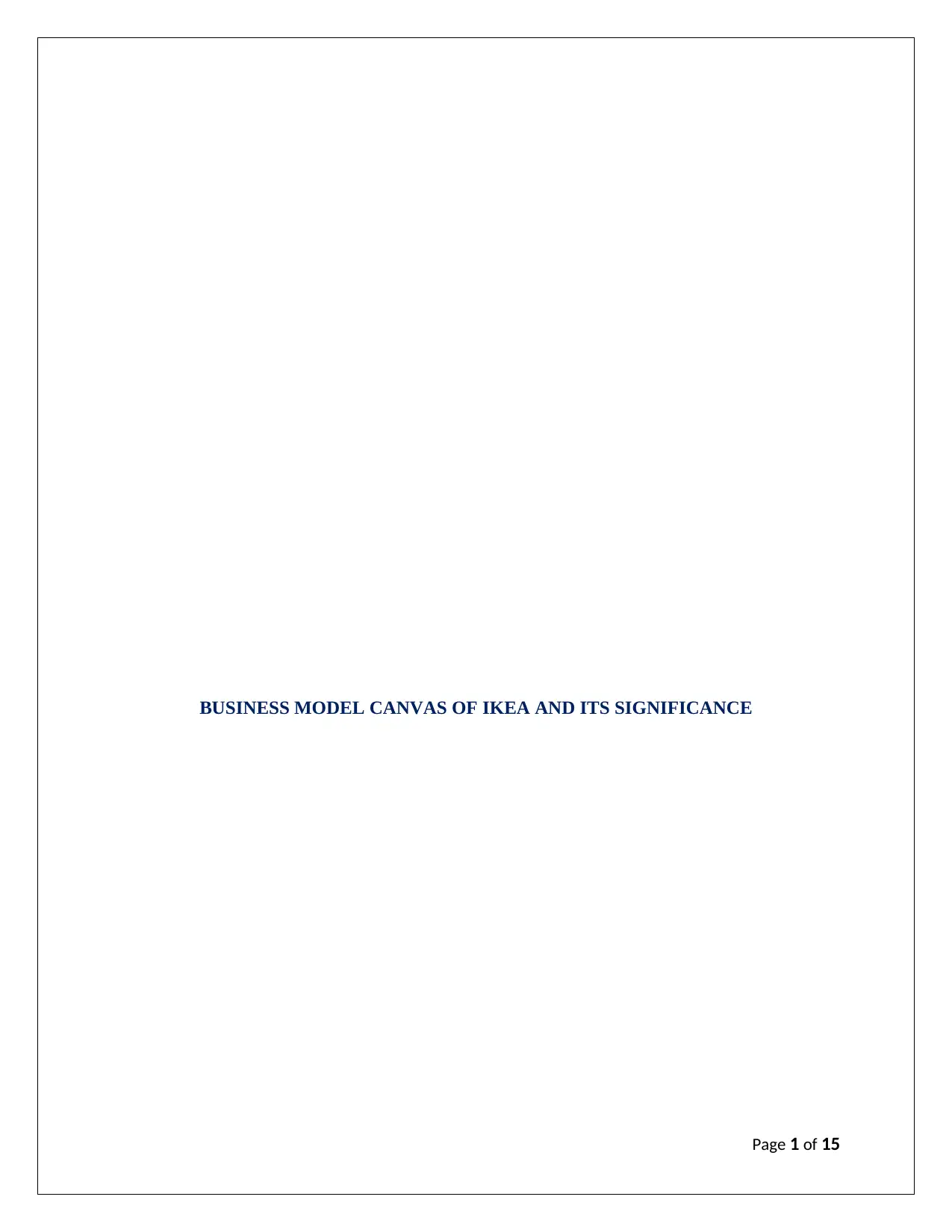
BUSINESS MODEL CANVAS OF IKEA AND ITS SIGNIFICANCE
Page 1 of 15
Page 1 of 15
Paraphrase This Document
Need a fresh take? Get an instant paraphrase of this document with our AI Paraphraser
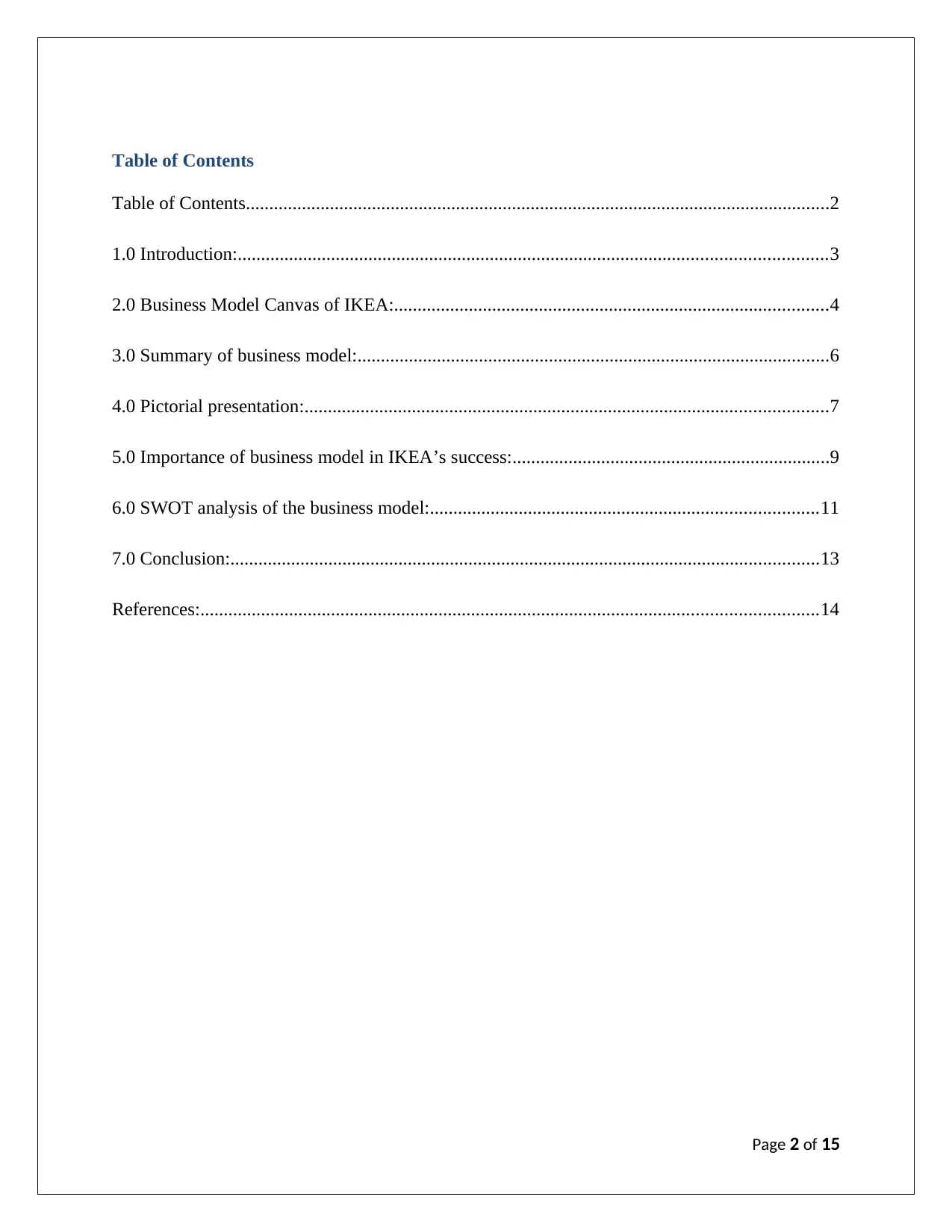
Table of Contents
Table of Contents.............................................................................................................................2
1.0 Introduction:..............................................................................................................................3
2.0 Business Model Canvas of IKEA:.............................................................................................4
3.0 Summary of business model:.....................................................................................................6
4.0 Pictorial presentation:................................................................................................................7
5.0 Importance of business model in IKEA’s success:....................................................................9
6.0 SWOT analysis of the business model:...................................................................................11
7.0 Conclusion:..............................................................................................................................13
References:....................................................................................................................................14
Page 2 of 15
Table of Contents.............................................................................................................................2
1.0 Introduction:..............................................................................................................................3
2.0 Business Model Canvas of IKEA:.............................................................................................4
3.0 Summary of business model:.....................................................................................................6
4.0 Pictorial presentation:................................................................................................................7
5.0 Importance of business model in IKEA’s success:....................................................................9
6.0 SWOT analysis of the business model:...................................................................................11
7.0 Conclusion:..............................................................................................................................13
References:....................................................................................................................................14
Page 2 of 15

1.0 Introduction:
A business model may be construed to be one of the key success-critical components for a
business organisation. The business model plays vital accountability in the success or failure of
an organization, as it explains how the business will earn revenue by managing the socio-cultural
and economic status within the present market. In the present report, a case study of IKEA has
been chosen to define its business model followed by an evaluation of the impact of the existing
business model in the light of the surrounding market status.
At the very outset of the study, the researcher provides an overview of the paper followed by the
discussion on the chosen organisation’s Business Model Canvas. The paper also provides a brief
evaluation of the said business model through pictorial presentation. In the subsequent pat of the
paper, the researcher assesses the importance of the aforementioned business model in the
context of the organisational success. While doing so, the model has been analysed against
SWOT framework and finally, the discussion is wrapped by way of concluding note.
Page 3 of 15
A business model may be construed to be one of the key success-critical components for a
business organisation. The business model plays vital accountability in the success or failure of
an organization, as it explains how the business will earn revenue by managing the socio-cultural
and economic status within the present market. In the present report, a case study of IKEA has
been chosen to define its business model followed by an evaluation of the impact of the existing
business model in the light of the surrounding market status.
At the very outset of the study, the researcher provides an overview of the paper followed by the
discussion on the chosen organisation’s Business Model Canvas. The paper also provides a brief
evaluation of the said business model through pictorial presentation. In the subsequent pat of the
paper, the researcher assesses the importance of the aforementioned business model in the
context of the organisational success. While doing so, the model has been analysed against
SWOT framework and finally, the discussion is wrapped by way of concluding note.
Page 3 of 15
⊘ This is a preview!⊘
Do you want full access?
Subscribe today to unlock all pages.

Trusted by 1+ million students worldwide
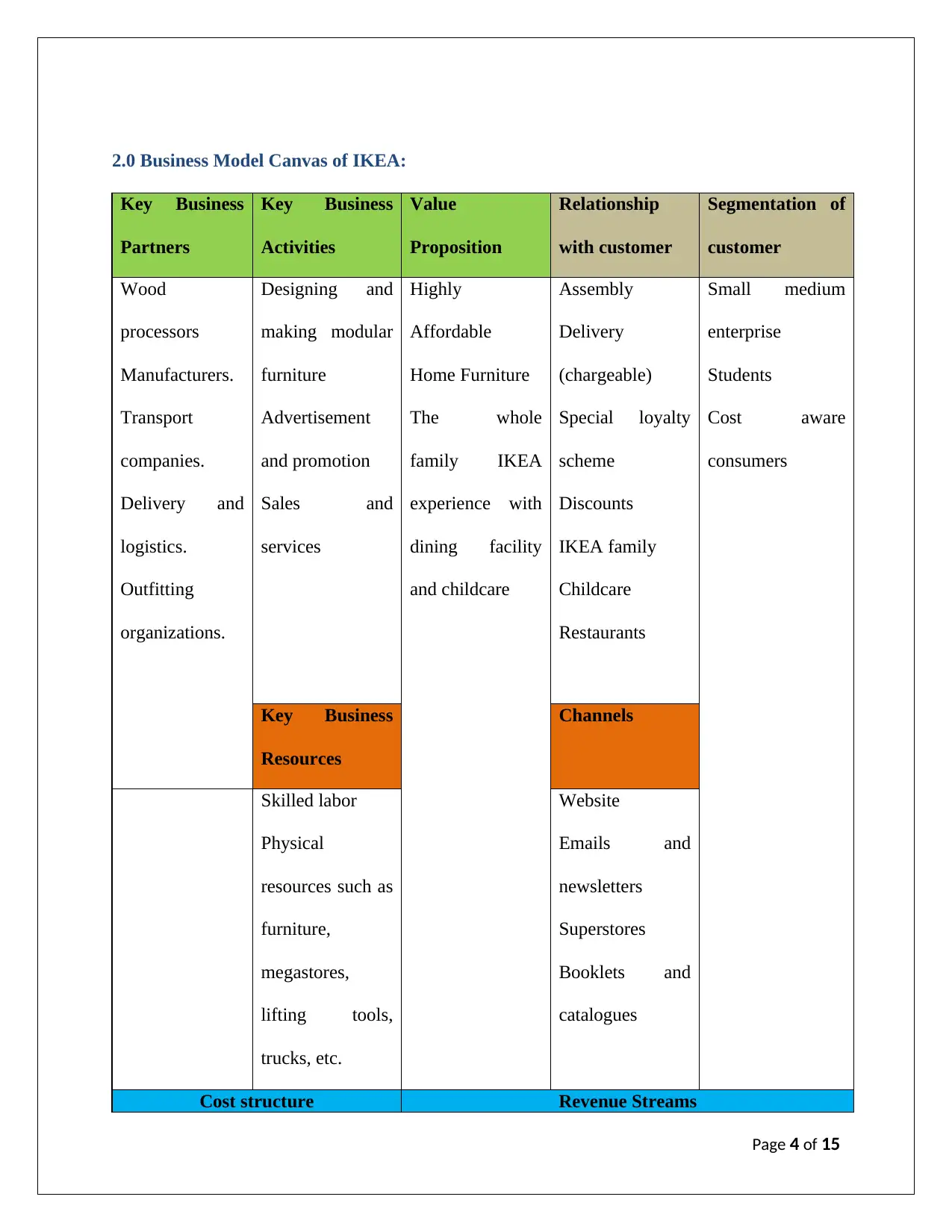
2.0 Business Model Canvas of IKEA:
Key Business
Partners
Key Business
Activities
Value
Proposition
Relationship
with customer
Segmentation of
customer
Wood
processors
Manufacturers.
Transport
companies.
Delivery and
logistics.
Outfitting
organizations.
Designing and
making modular
furniture
Advertisement
and promotion
Sales and
services
Highly
Affordable
Home Furniture
The whole
family IKEA
experience with
dining facility
and childcare
Assembly
Delivery
(chargeable)
Special loyalty
scheme
Discounts
IKEA family
Childcare
Restaurants
Small medium
enterprise
Students
Cost aware
consumers
Key Business
Resources
Channels
Skilled labor
Physical
resources such as
furniture,
megastores,
lifting tools,
trucks, etc.
Website
Emails and
newsletters
Superstores
Booklets and
catalogues
Cost structure Revenue Streams
Page 4 of 15
Key Business
Partners
Key Business
Activities
Value
Proposition
Relationship
with customer
Segmentation of
customer
Wood
processors
Manufacturers.
Transport
companies.
Delivery and
logistics.
Outfitting
organizations.
Designing and
making modular
furniture
Advertisement
and promotion
Sales and
services
Highly
Affordable
Home Furniture
The whole
family IKEA
experience with
dining facility
and childcare
Assembly
Delivery
(chargeable)
Special loyalty
scheme
Discounts
IKEA family
Childcare
Restaurants
Small medium
enterprise
Students
Cost aware
consumers
Key Business
Resources
Channels
Skilled labor
Physical
resources such as
furniture,
megastores,
lifting tools,
trucks, etc.
Website
Emails and
newsletters
Superstores
Booklets and
catalogues
Cost structure Revenue Streams
Page 4 of 15
Paraphrase This Document
Need a fresh take? Get an instant paraphrase of this document with our AI Paraphraser
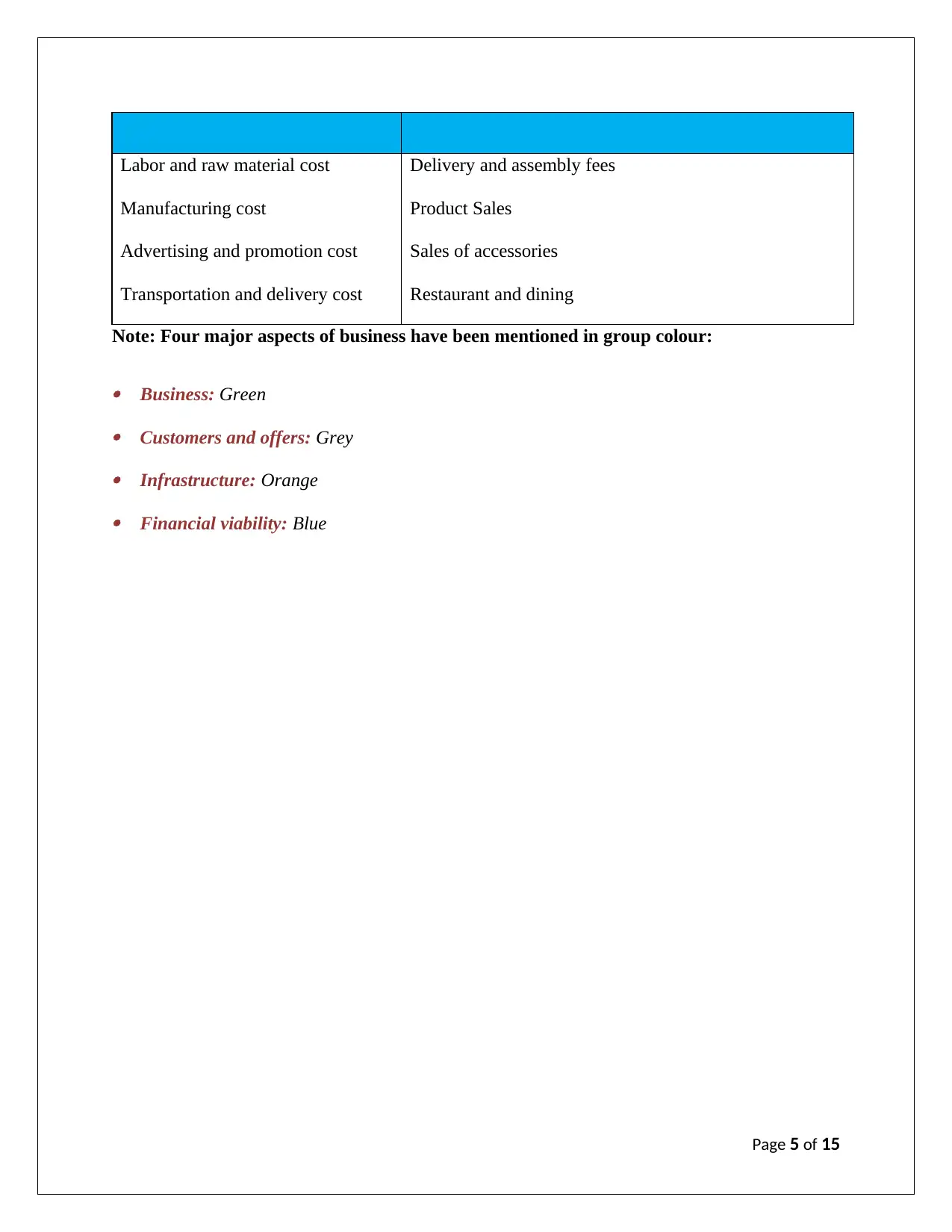
Labor and raw material cost
Manufacturing cost
Advertising and promotion cost
Transportation and delivery cost
Delivery and assembly fees
Product Sales
Sales of accessories
Restaurant and dining
Note: Four major aspects of business have been mentioned in group colour:
Business: Green
Customers and offers: Grey
Infrastructure: Orange
Financial viability: Blue
Page 5 of 15
Manufacturing cost
Advertising and promotion cost
Transportation and delivery cost
Delivery and assembly fees
Product Sales
Sales of accessories
Restaurant and dining
Note: Four major aspects of business have been mentioned in group colour:
Business: Green
Customers and offers: Grey
Infrastructure: Orange
Financial viability: Blue
Page 5 of 15

3.0 Summary of business model:
After a successful evaluation of the business model, it is clear that IKEA follows Porter’s
Generic Strategy and it helps the brand achieving a greater degree of success. IKEA is
considered as the lower cost organization in the furniture industry. The input cost drivers include
sourcing of varied components from diversified suppliers. Saraswati (2018) also stated that high
volume manufacturing and offerings of disassembled components minimize the cost of inventory
and acts as the source of competitive advantage. Highly affordable home furniture and the
unique discount and loyalty scheme are also found the sources of customer attraction. The
segmentation with young customers also found a clever targeting and hitting the demographic
approach. In addition, Jae-Woong Byun (2011) stated that usage of the basic key business
parameters such as skilled labour, physical resources, etc. are also cost-effective with respect to
other marketers, as IKEA is free from procurement charges. The advertising channels are also
cost-effective and extensive use of information technology has enabled the brand targeting e-
commerce customers through adequate loyalty and discount offerings (Alänge et al. 2016). On
the other hand, IKEA has large sizes showroom and elaborate cafeteria where the family can
spend time while shopping from the stores, which is the value proposition of IKEA (Naggar,
2015). The cost structure includes mainly manufacturing and raw material, transportation and
delivery of the products. However, the advertising and promotional cost are found lesser as the
brand mainly conducts online promotions through social media and email communications. The
revenue comes from the sales of accessories and product streams. In addition, assembly fees are
taken on a successful request placed by the customers as a part of the service charge and the
restaurant facility creates additional revenue for the company and makes the brand more
sustainable (Ikea.com, 2019).
Page 6 of 15
After a successful evaluation of the business model, it is clear that IKEA follows Porter’s
Generic Strategy and it helps the brand achieving a greater degree of success. IKEA is
considered as the lower cost organization in the furniture industry. The input cost drivers include
sourcing of varied components from diversified suppliers. Saraswati (2018) also stated that high
volume manufacturing and offerings of disassembled components minimize the cost of inventory
and acts as the source of competitive advantage. Highly affordable home furniture and the
unique discount and loyalty scheme are also found the sources of customer attraction. The
segmentation with young customers also found a clever targeting and hitting the demographic
approach. In addition, Jae-Woong Byun (2011) stated that usage of the basic key business
parameters such as skilled labour, physical resources, etc. are also cost-effective with respect to
other marketers, as IKEA is free from procurement charges. The advertising channels are also
cost-effective and extensive use of information technology has enabled the brand targeting e-
commerce customers through adequate loyalty and discount offerings (Alänge et al. 2016). On
the other hand, IKEA has large sizes showroom and elaborate cafeteria where the family can
spend time while shopping from the stores, which is the value proposition of IKEA (Naggar,
2015). The cost structure includes mainly manufacturing and raw material, transportation and
delivery of the products. However, the advertising and promotional cost are found lesser as the
brand mainly conducts online promotions through social media and email communications. The
revenue comes from the sales of accessories and product streams. In addition, assembly fees are
taken on a successful request placed by the customers as a part of the service charge and the
restaurant facility creates additional revenue for the company and makes the brand more
sustainable (Ikea.com, 2019).
Page 6 of 15
⊘ This is a preview!⊘
Do you want full access?
Subscribe today to unlock all pages.

Trusted by 1+ million students worldwide

4.0 Pictorial presentation:
The pictorial presentation has been made considering the values based on the existing business
model canvas. The range (0-100) has been set according to the contribution of each factor in
IKEA’s business growth and success.
Parameters of Business
Model Canvas
Value based on the existing
business model (0-100 scale)
Quality 85
Design 65
Range 60
Price 10
Service 45
Customization 20
Instant fulfilment 90
Business partners 90
Loyalty and discount 80
Segmentation 30
Business resources 75
Channels 65
Revenue stream 87
Cost structure 25
Table 1: Business Model canvas and values of each parameter
(Source: Created by author)
Page 7 of 15
The pictorial presentation has been made considering the values based on the existing business
model canvas. The range (0-100) has been set according to the contribution of each factor in
IKEA’s business growth and success.
Parameters of Business
Model Canvas
Value based on the existing
business model (0-100 scale)
Quality 85
Design 65
Range 60
Price 10
Service 45
Customization 20
Instant fulfilment 90
Business partners 90
Loyalty and discount 80
Segmentation 30
Business resources 75
Channels 65
Revenue stream 87
Cost structure 25
Table 1: Business Model canvas and values of each parameter
(Source: Created by author)
Page 7 of 15
Paraphrase This Document
Need a fresh take? Get an instant paraphrase of this document with our AI Paraphraser

Quality
Design
Range
Price
Service
Customisation
Instant fulfillment
Business partners
Loyalty and discount
Segmentation
Business resources
Channels
Revenue stream
Cost structure
0
10
20
30
40
50
60
70
80
90
100
85
65 60
10
45
20
90 90
80
30
75
65
87
25
Pictorial Presentation of Business Model Canvas of IKEA
Value based on the existing
business model (0-100 scale)
Figure 1: Business Model canvas and values of each parameter
(Source: Created by author)
Page 8 of 15
Design
Range
Price
Service
Customisation
Instant fulfillment
Business partners
Loyalty and discount
Segmentation
Business resources
Channels
Revenue stream
Cost structure
0
10
20
30
40
50
60
70
80
90
100
85
65 60
10
45
20
90 90
80
30
75
65
87
25
Pictorial Presentation of Business Model Canvas of IKEA
Value based on the existing
business model (0-100 scale)
Figure 1: Business Model canvas and values of each parameter
(Source: Created by author)
Page 8 of 15
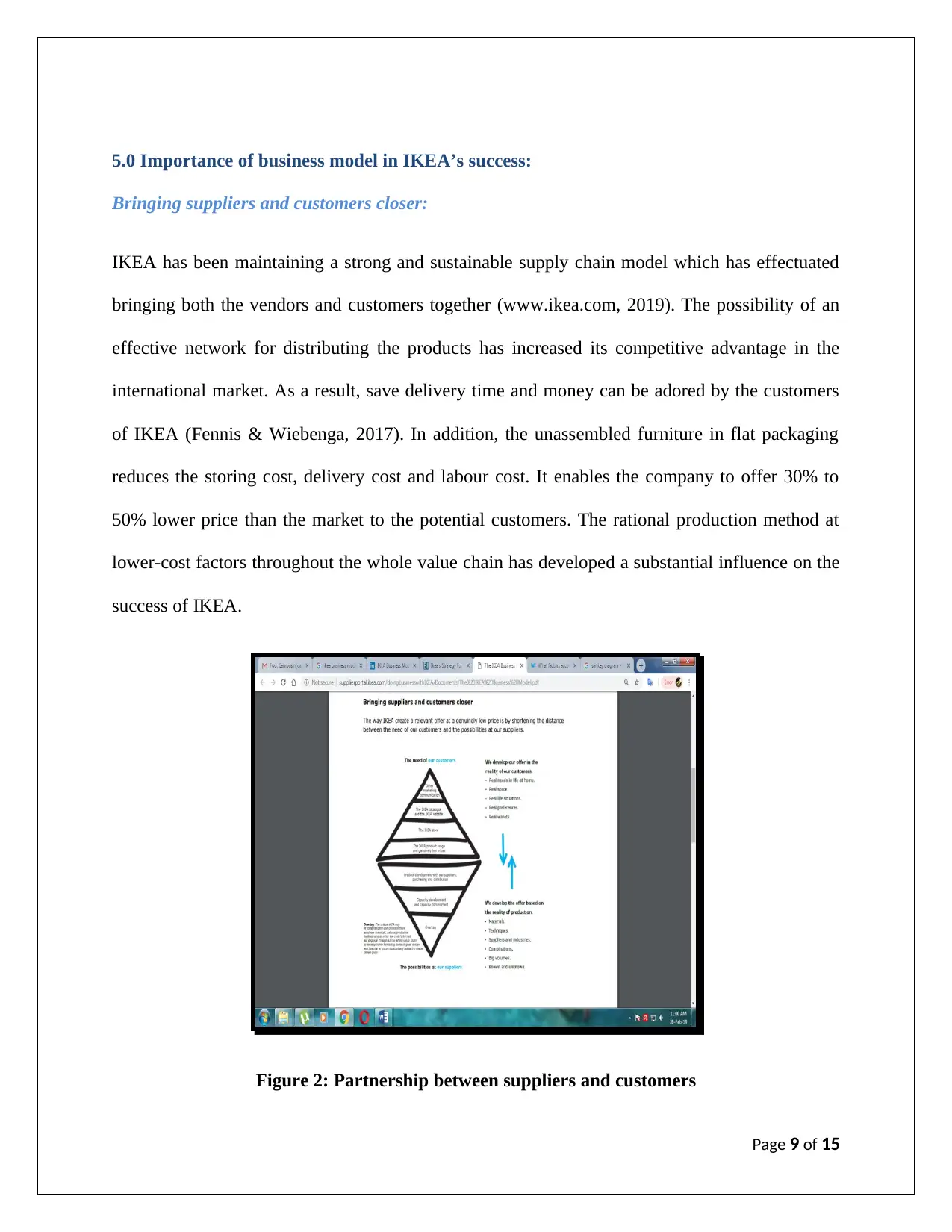
5.0 Importance of business model in IKEA’s success:
Bringing suppliers and customers closer:
IKEA has been maintaining a strong and sustainable supply chain model which has effectuated
bringing both the vendors and customers together (www.ikea.com, 2019). The possibility of an
effective network for distributing the products has increased its competitive advantage in the
international market. As a result, save delivery time and money can be adored by the customers
of IKEA (Fennis & Wiebenga, 2017). In addition, the unassembled furniture in flat packaging
reduces the storing cost, delivery cost and labour cost. It enables the company to offer 30% to
50% lower price than the market to the potential customers. The rational production method at
lower-cost factors throughout the whole value chain has developed a substantial influence on the
success of IKEA.
Figure 2: Partnership between suppliers and customers
Page 9 of 15
Bringing suppliers and customers closer:
IKEA has been maintaining a strong and sustainable supply chain model which has effectuated
bringing both the vendors and customers together (www.ikea.com, 2019). The possibility of an
effective network for distributing the products has increased its competitive advantage in the
international market. As a result, save delivery time and money can be adored by the customers
of IKEA (Fennis & Wiebenga, 2017). In addition, the unassembled furniture in flat packaging
reduces the storing cost, delivery cost and labour cost. It enables the company to offer 30% to
50% lower price than the market to the potential customers. The rational production method at
lower-cost factors throughout the whole value chain has developed a substantial influence on the
success of IKEA.
Figure 2: Partnership between suppliers and customers
Page 9 of 15
⊘ This is a preview!⊘
Do you want full access?
Subscribe today to unlock all pages.

Trusted by 1+ million students worldwide
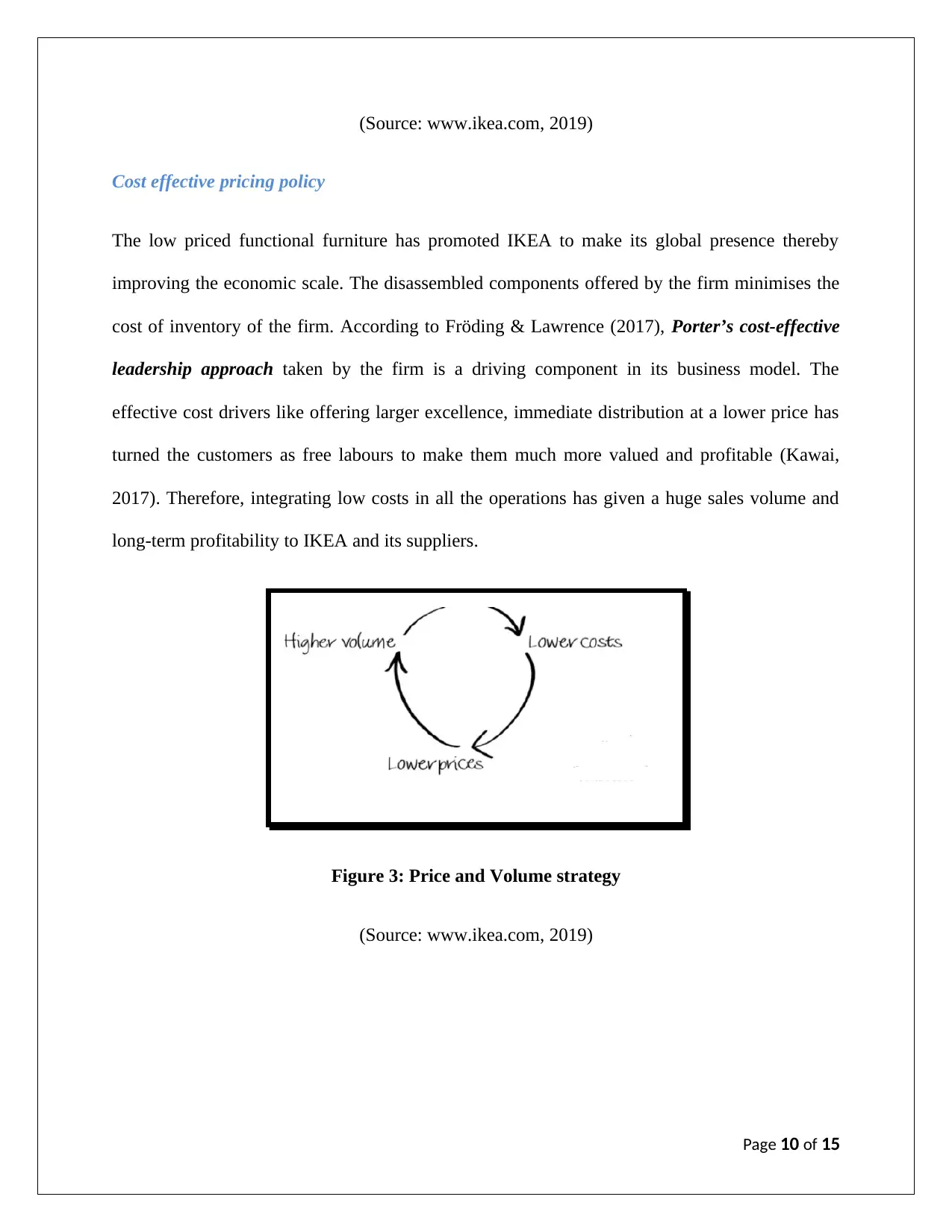
(Source: www.ikea.com, 2019)
Cost effective pricing policy
The low priced functional furniture has promoted IKEA to make its global presence thereby
improving the economic scale. The disassembled components offered by the firm minimises the
cost of inventory of the firm. According to Fröding & Lawrence (2017), Porter’s cost-effective
leadership approach taken by the firm is a driving component in its business model. The
effective cost drivers like offering larger excellence, immediate distribution at a lower price has
turned the customers as free labours to make them much more valued and profitable (Kawai,
2017). Therefore, integrating low costs in all the operations has given a huge sales volume and
long-term profitability to IKEA and its suppliers.
Figure 3: Price and Volume strategy
(Source: www.ikea.com, 2019)
Page 10 of 15
Cost effective pricing policy
The low priced functional furniture has promoted IKEA to make its global presence thereby
improving the economic scale. The disassembled components offered by the firm minimises the
cost of inventory of the firm. According to Fröding & Lawrence (2017), Porter’s cost-effective
leadership approach taken by the firm is a driving component in its business model. The
effective cost drivers like offering larger excellence, immediate distribution at a lower price has
turned the customers as free labours to make them much more valued and profitable (Kawai,
2017). Therefore, integrating low costs in all the operations has given a huge sales volume and
long-term profitability to IKEA and its suppliers.
Figure 3: Price and Volume strategy
(Source: www.ikea.com, 2019)
Page 10 of 15
Paraphrase This Document
Need a fresh take? Get an instant paraphrase of this document with our AI Paraphraser

6.0 SWOT analysis of the business model:
Strengths:
The distinct business strategy of IKEA and its stout policy of retailing is its pioneering attribute
to rule over the competitors and acquiring an effective positioning in the global marketplace
(Fennis & Wiebenga, 2017). Considering the words of Joyce & Paquin (2016), an array of
unassembled product offered by the firm has rendered a self-service facility to the customers and
that also leads to an immense cost reduction to the target group. The single-minded cost
leadership approach has directly enhanced the operational competences of the firm and assists it
to retain its customers’ footfalls (Chopra, 2019).
Weaknesses:
The high scale business volume of IKEA sometimes makes it inflexible to control its product
standard and quality across the globe. Moreover, the total quality management (TQM) for all
products is not at par with the industry benchmark (Kawai, 2017). Hence, it signifies a weak
linkage in IKEA’s supply chain process and customer satisfaction. In this context, it may be
noted that the deficiencies within the TQM strategy may lead to an inefficient business process
that adversely affects the operational flow of the firm in the long-run.
Opportunities:
The green business model used by IKEA has an enormous prospect in terms of attracting
customers who actually wish to buy these kinds of products. The rise of ethical customers can
influence IKEA to make more substantial agenda in producing greener products (Chopra, 2019).
Page 11 of 15
Strengths:
The distinct business strategy of IKEA and its stout policy of retailing is its pioneering attribute
to rule over the competitors and acquiring an effective positioning in the global marketplace
(Fennis & Wiebenga, 2017). Considering the words of Joyce & Paquin (2016), an array of
unassembled product offered by the firm has rendered a self-service facility to the customers and
that also leads to an immense cost reduction to the target group. The single-minded cost
leadership approach has directly enhanced the operational competences of the firm and assists it
to retain its customers’ footfalls (Chopra, 2019).
Weaknesses:
The high scale business volume of IKEA sometimes makes it inflexible to control its product
standard and quality across the globe. Moreover, the total quality management (TQM) for all
products is not at par with the industry benchmark (Kawai, 2017). Hence, it signifies a weak
linkage in IKEA’s supply chain process and customer satisfaction. In this context, it may be
noted that the deficiencies within the TQM strategy may lead to an inefficient business process
that adversely affects the operational flow of the firm in the long-run.
Opportunities:
The green business model used by IKEA has an enormous prospect in terms of attracting
customers who actually wish to buy these kinds of products. The rise of ethical customers can
influence IKEA to make more substantial agenda in producing greener products (Chopra, 2019).
Page 11 of 15
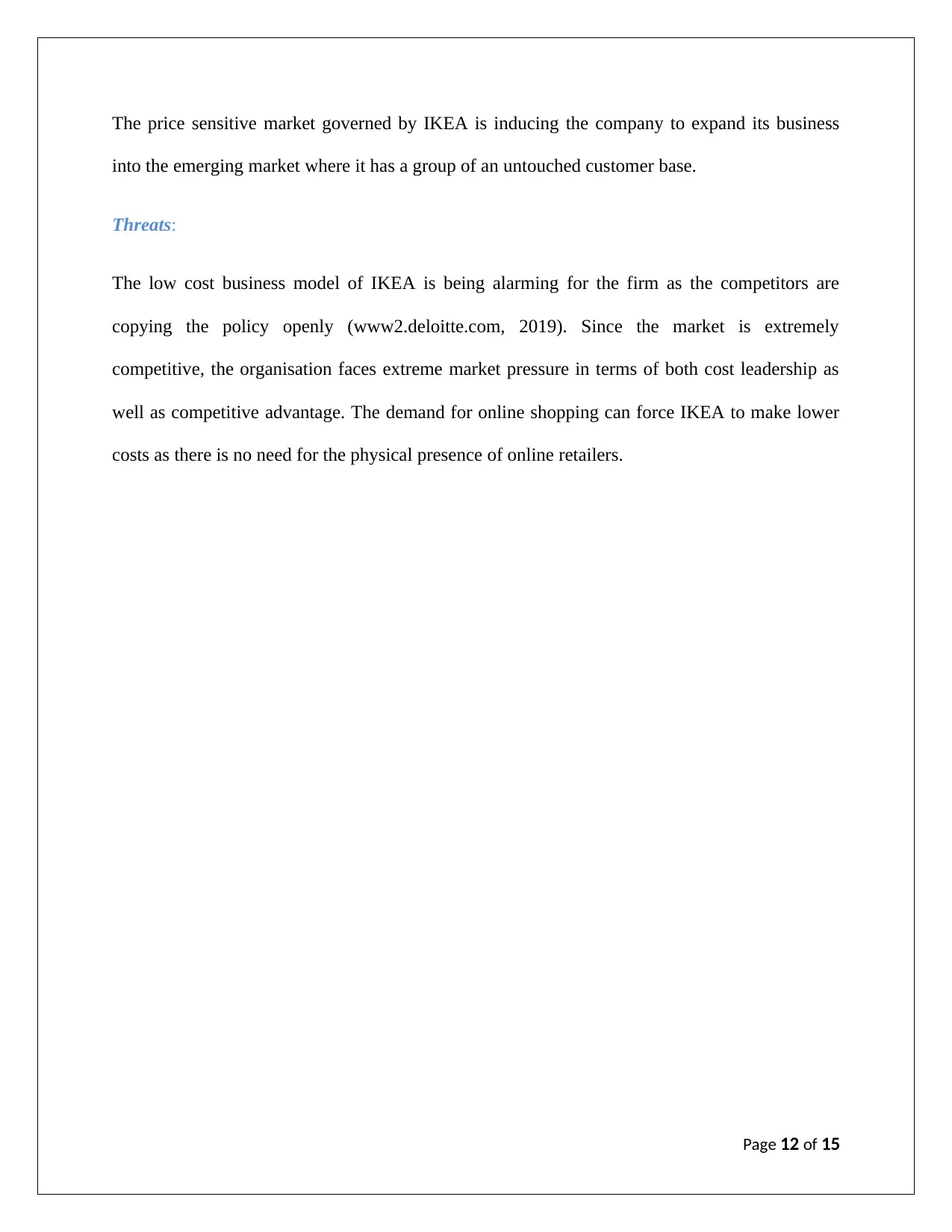
The price sensitive market governed by IKEA is inducing the company to expand its business
into the emerging market where it has a group of an untouched customer base.
Threats:
The low cost business model of IKEA is being alarming for the firm as the competitors are
copying the policy openly (www2.deloitte.com, 2019). Since the market is extremely
competitive, the organisation faces extreme market pressure in terms of both cost leadership as
well as competitive advantage. The demand for online shopping can force IKEA to make lower
costs as there is no need for the physical presence of online retailers.
Page 12 of 15
into the emerging market where it has a group of an untouched customer base.
Threats:
The low cost business model of IKEA is being alarming for the firm as the competitors are
copying the policy openly (www2.deloitte.com, 2019). Since the market is extremely
competitive, the organisation faces extreme market pressure in terms of both cost leadership as
well as competitive advantage. The demand for online shopping can force IKEA to make lower
costs as there is no need for the physical presence of online retailers.
Page 12 of 15
⊘ This is a preview!⊘
Do you want full access?
Subscribe today to unlock all pages.

Trusted by 1+ million students worldwide
1 out of 15
Related Documents
Your All-in-One AI-Powered Toolkit for Academic Success.
+13062052269
info@desklib.com
Available 24*7 on WhatsApp / Email
![[object Object]](/_next/static/media/star-bottom.7253800d.svg)
Unlock your academic potential
Copyright © 2020–2025 A2Z Services. All Rights Reserved. Developed and managed by ZUCOL.




